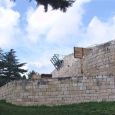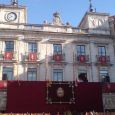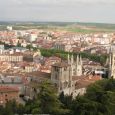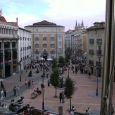Burgos
Advertisement
By plane
Burgos-Villafria airport was opened in 2008 with daily flights to Barcelona. If possible fly to Paris-Orly and Palma de Mallorca in the weekends. Air Nostrum, an Iberia-affiliated airline, also has flights from Burgos to Albacete, Ibiza, Bolonia, Nice, and London (all via Barcelona). There you can take a taxi or a bus (L25) that costs 0.85€. Other major airports near Burgos are Madrid (240 km), Bilbao (160 km), Santander (160 km) and Valladolid (125km). There are several connections by train or bus between these cities and Burgos. If you are arriving Madrid you can take a bus in the Intercambiador of Avenida de America or a train in Chamartin railway station, the trip takes less than 3h.
By train
Burgos Rosa de Lima is the name of the railway station of the city.It´s 24h open and you can buy tickets there from 7:15 am to 10:30pm or online in Renfe web. It´s 5km far away from the city center but there are buses and taxis you can take. Burgos Rosa de Lima railway station offers high speed connections (Alvia) with Barcelona, Bilbao, Hendaya, Gijon, Madrid or Vigo. Also it has connections with other nacional (like Salamanca, Leon, Vitoria, San Sebastián...) and international cities (Lisbon, Coimbra and Paris).
By bus
Burgos is well connected by bus to many other cities in Northern Spain, and taking the bus is often faster than taking the train. The bus station is in the center of the city, next to Plaza vega in the Calle Miranda nº4-6. You can download schedules of national an international services. Taking a bus is the best option if you want to travel to Madrid, there are several coaches during the day and the trip takes only 2h 45min, the company who travel to Madrid is Alsa, you can buy tickets online.
By car
Burgos has a privileged location between the centre and the north of Spain. Several roads cross the city and it´s easy to arrive Burgos by car.
From Santander take the main road N623 and 627 or the A231 and A67 divided highway.
From Madrid take the A-1 divided highway.
From Zaragoza and Cataluña take the AP-68 motorway at Miranda de Ebro take the AP-1 motorway.
From Portugal and Valladolid take the A-62 divided highway.
From France and the Basque Country take the AP-1 motorway.
Arco de Santa Maria
The Arco de Santa Maria is one of the most important monuments of the city of Burgos ( Spain ). One of the old twelve gates into the city in the Middle Ages, reports the Santa Maria Bridge on the River Arlanzon, with the Plaza de San Fernando, where stands the cathedral. Originally built in the fourteenth century - XV, in the next century, especially between 1536 and 1553, was completely remodeled by Juan de Vallejo and Francisco de Colonia, leading to the entry made with the typical limestone white Burgos, this time from from quarries Quarry Hontoria which can be seen today.
Castillo de Burgos
Burgos Castle is a fortress located in the city Spanish of Burgos. It is on the hill of San Miguel 75 m high above the city. Raised by Count Diego Rodriguez Porcelos at the time of the Reconquista, the year 884, although there were ancient fortifications.
Museum of Burgos
Burgos Museum, formerly the Provincial Archaeological Museum, has its offices in two adjoining palaces of the sixteenth century, the Casa de Miranda and Angulo Inigo House, forming a block between Calera and Miranda streets in the city of Burgos ( Spain ). The museum's collections are derived exclusively from Burgos, origin or destination and show the historical and cultural evolution of the province.
Casa del Cordon
The Palace of the Constables of Castile popularly known as Cord house is a palace originally from the fifteenth century, which stands in the old town of Burgos, chairing the Major Market Square today denomidada Freedom Square. Its driving force was the Constable of Castile Don Pedro Fernandez de Velasco, married to Dona Mencia de Mendoza y Figueroa.
Teatro Principal
The Teatro Principal of Burgos is a great style building Elizabethan located at the beginning of Paseo del Jetty, opposite the palace of the Provincial Government. Elizabethan style, was begun in 1843 by Bernardino Martinez de Velasco, under the leadership of Francisco de Angoitia and was opened in 1858.
Bridge of San Pablo
The Bridge of San Pablo is located in the city of Burgos, allowing cross the river Arlanzon communicating with the old walled Convent of San Pablo. Originally defended the tower of the same name and according to tradition was built at the expense of the Brotherhood of the Magi, founded by Count Fernan Gonzalez, and commonly known as the Brotherhood of the Knights 13, as is established in its statutes and its members should not exceed that number.
Plaza de Alonso Martinez
The Plaza de Alonso Martinez is a city square in the Spanish of Burgos. Has a significant historical importance, for from the General Captaincy Palace pleaded Francisco Franco head of the armies of Spain in 1936. It is located northeast of the historic old city, with its entrance next to the Avenida del Cid Campeador.
Malatos Bridge
Malatos Bridge is located in Burgos, city Spanish in the north of the Iberian Peninsula. Lets cross the river Arlanzon communicating the district San Pedro de la Fuente with the Hospital of the King, allowed qaue pilgrims traveled the Camino de Santiago, crossing the river once crossed the city. It is a bridge of stone reserved for pedestrians.
Monasterio de San Francisco de Burgos
Monasterio de San Francisco de Burgos. Monastery Franciscan, now disappeared, located in the city of Burgos, Spain. According to what the tradition was founded by St. Francis of Assisi in 1213, having previously obtained the approval of King Alfonso VIII of Castile. The monastery of San Francisco was demolished in 1837, during the reign of Isabel II.
Major Market Square
The Major Market Square today denomidana of Liberty, is a square located in the old town of Burgos, city Spanish in the north of the Iberian Peninsula. The name of the market comes from the celebration of the markets that were formerly in the city, and the Mayor of such a size as to the early nineteenth century was a single square with the current Santo Domingo de Guzman separated by Anton the arcades, built in the center of the plaza.
Town Hall Burgos
The town hall of Burgos are located in the Lower Market Square, officially called Plaza Mayor, in the old city of Burgos, city Spanish in the north of the Iberian Peninsula. In 1712 the Burgos City Council agrees that the walls disappear, especially those that surrounded the lower part, and the first step taken was aimed at the construction of some houses Consitoriales, choosing for its location the place of the door carts. The council held its sessions in the tower of Santa Maria, whose small size did not allow many meetings.
Monasterio de Santa Maria la Real de Las Huelgas
The monastery of Santa Maria la Real de Las Huelgas is a monastery of the Congregation of Cistercian monasteries of San Bernardo. It was founded in 1189 by King Alfonso VIII of Castile .It houses valuable works, including some of the oldest stained glass windows of Spain.
Palacio de Castilfale
Frente a la puerta de la Coroneria de la catedral, se levanto la casa de Los Colonia, en la segunda mitad del siglo XV. Sobre el solar de la misma, Juan Vallejo inicio la construccion de un palacio adquirido en 1565 por Andres de Maluenda. Aunque el edificio, hecho de piedra y ladrillo, como era habitual en la arquitectura domestica burgalesa, fue transformado por sus sucesivos propietarios; el último, en el siglo XX, fue el conde de Castilfale. Fue residencia ocasional de personalidades como el rey Fernando VII y de Napoleon Bonaparte. Cedido por sus últimos propietarios, los condes de Castilfale, al Ayuntamiento de Burgos en 1969, fue restaurado y rehabilitado como Archivo Municipal, en 1985.
February - June






